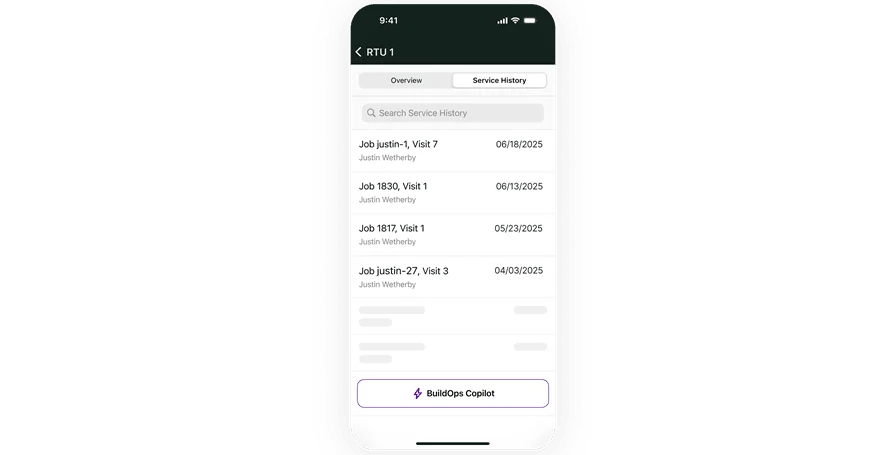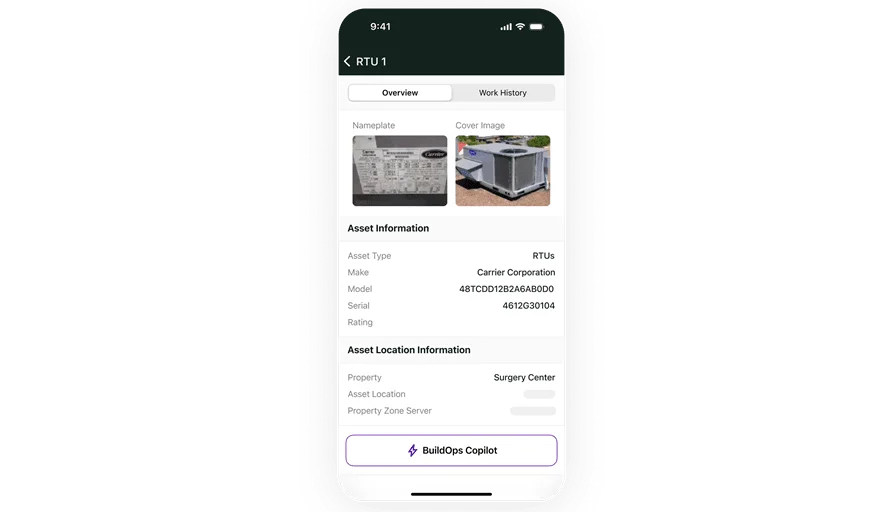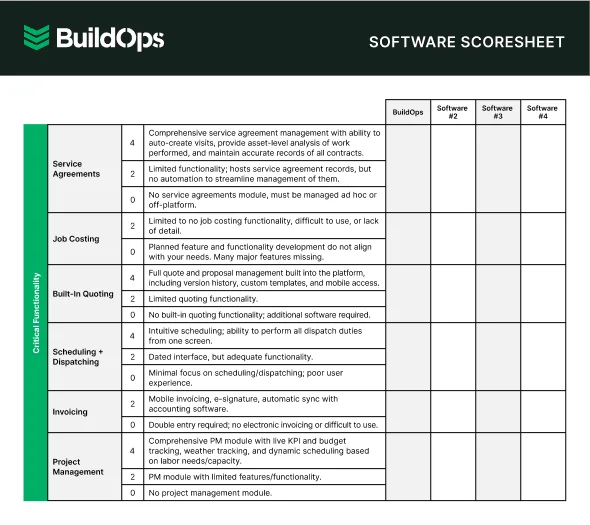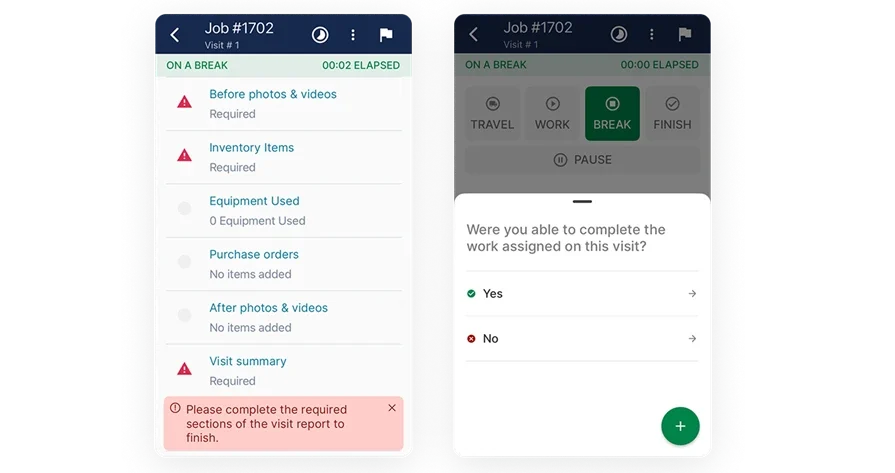Managing a field crew without mobility tools? That’s asking for missteps. Between shifting job details, scattered communication, and technicians constantly on the move, field service work demands more than a clipboard and a good memory. You need tech that works where the work happens. That’s where field service mobility software steps in—bringing real-time access, job clarity, and smarter workflows right to your crew’s hands.
This guide breaks down how today’s top contractors are using field service mobility to stay ahead—from smoother dispatching and job tracking to offline access and live updates. It’s a core part of what makes a strong field service management strategy. If you're looking to keep jobs tight and teams synced, mobility isn’t optional—it’s foundational. Here’s everything we’ll cover, including:
- Choosing the right field service mobility software for your team
- 6 key features to look for in a quality field mobility software
- 5 top-rated field service mobility software & tools
- 7 key benefits of using field service mobility solutions
- 4 important FAQs on field service mobility software answered
In the next section, we’ll break down what to look for in field mobility software—the questions to ask, the traps to avoid, and the real-world needs your team actually faces on-site.
Choosing the right field service mobility software for your team
Effective field service relies on more than just office efficiency; it hinges on field operations. If your system is office-bound, field crews lag behind. They require fast, dependable access to the same tools, updates, and data used by office staff for planning and managing tasks. Field service mobility software bridges this gap, equipping every team member with necessary resources on the job site.
Before you start comparing platforms, take a step back. The best software matches how your teams already work, not the other way around. That means evaluating tools through the lens of your techs, your dispatchers, and your workflows—not just a feature list. Here’s what to focus on when sizing up field mobility software for your operation:
- Mobile usability - How well does the platform run on the phones and tablets your team already uses? Can technicians open schedules, access job files, or view customer notes without delays or frustration? Is the layout designed specifically for mobile use—or is it repurposed from a desktop setup?
- Field-to-office syncing - How quickly do updates from the field reach your back office or dispatcher? Can office staff see job progress in real time as technicians work through tasks? Does the platform handle simultaneous updates across different users and roles?
- Offline performance - What happens when a tech is out of signal range—can they still log work, take notes, or upload photos? Will everything sync cleanly once they reconnect, without lost data? How dependable is the platform in locations where cell coverage is spotty or unreliable?
- Learning curve for techs - Can new team members understand the system without sitting through hours of training? Is the interface clean enough for fast use between job steps, even on tough, fast-paced days? Are everyday actions—like completing a job, adding a note, or snapping a photo—fast and obvious?
- Features - Can the software support workflows like flagging additional repairs, attaching jobsite photos, or recording voice notes? Does it allow the team to log recommended work or upsells without waiting until they return to the office? Can both field techs and office staff rely on the same system to track tasks, updates, and job history in one place?
When both the field and office work from a shared source of truth, jobs run cleaner and faster. The right field service mobility software brings that connection to life—making communication seamless, job tracking easier, and updates instant. Next, we’ll dive into the six core features every strong platform should have—and why they matter when your crew is deep in the work.
6 key features to look for in a quality field mobility software
Strong field service mobility starts with the tools techs actually use in the field. Software can promise a lot—but unless it delivers right there on the job site, it slows your team down.
Think about a plumbing contractor with five vans out on different jobs. One tech hits traffic, another finishes early, and the third runs into an unexpected repair that needs sign-off. The office needs to know what’s happening, when to reshuffle, and how to bill for that extra work—fast. That’s exactly where field service mobility software makes the difference. With the right features, your crews can adjust on the fly, keep communication clean, and finish work without circling back to the office.
Here are six must-have features built for the way field teams really work.
1. Mobile app built for technicians
Mobility starts with the tool in a tech’s hand. A dedicated technician mobile app gives your crew everything they need—from job details to photo uploads—without needing a laptop or even a hotspot. It should work on any job site, whether that’s a rooftop, boiler room, or underground utility vault.
Let’s say your HVAC tech is troubleshooting on a commercial rooftop in July. They finish the job, snap a photo, log the task, and update the work order—all before heading back down. No missed steps, no paperwork waiting back at the shop. This kind of real-time logging and access makes field service mobility software a must-have, not a nice-to-have.

Connect field & office seamlessly
Everything in the BuildOps desktop platform is accessible to your techs on their mobile devices.
2. Dynamic scheduling tools
Workloads shift by the hour. Smart scheduling tools let you assign and reassign jobs without blowing up the day. Look for features that show tech availability in real time, support drag-and-drop rescheduling, and update everyone the moment changes happen.
Say your electrical crew is running two emergency jobs and a service call cancels last minute. Instead of calling around, your dispatcher checks the board, sees who’s freed up, and reassigns them to a priority call nearby. No downtime, no confusion. With field mobility software, that kind of flexibility becomes your new normal.
3. Live dispatch visibility
A real-time dispatch platform keeps your team coordinated as jobs shift throughout the day. You should be able to view where crews are, see job status updates, and adjust routes or assignments as things come up.
Consider this: A fire protection tech finishes early, but no one at the office knows. Instead of waiting, dispatch sees it instantly and reroutes the tech to a nearby follow-up job. That’s how field service mobility solutions tighten your schedule and help techs cover more ground.
4. CRM access on the go
Field techs need more than a job sheet—they need access to the full story. A mobile-ready CRM system keeps contact info, job history, site notes, and asset details right in their hands.
Think about a refrigeration tech walking into a facility they haven’t serviced in over a year. With a few taps, they’re looking at past service logs, key site contacts, and even tagged problem areas from last time. That kind of detail helps them solve problems faster and builds long-term client trust. CRM tools embedded in field service mobility software bring office-level clarity to every service call.
5. On-site quoting tools
When techs find unexpected work, delays come from going back and forth with the office. Quoting software that works in the field means they can build and send quotes before even leaving the job site.
Take a technician doing a routine maintenance check who uncovers corrosion on key piping. Instead of waiting to quote it later, they generate a custom estimate on-site and send it to the client immediately. No delays, no lost upsells. Field mobility software should support your team’s ability to quote and close jobs on the spot.
6. Fast invoicing and payment
Finishing a job should mean finishing the paperwork too. Look for invoicing and payment tools that techs can use in the field—right when the job is done. This tightens cash flow and improves the customer experience.
For example, after completing a fire alarm system test at a commercial property, your crew finalizes the checklist and sends the invoice before heading to the next job. No billing backlog, no follow-up calls. These tools are essential for any team looking to tighten operations through field service workforce mobility.
Other valuable field mobility software features to look for
While the core six features lay the foundation for effective field service mobility, some platforms go further—offering add-ons that enhance how your team manages time, contracts, and performance tracking. These features are not always dealbreakers, but they can provide serious operational value once your baseline is covered. Here are three additional features that help strengthen field mobility across scheduling, service, and strategy:
- Integrated time tracking - Time tracking tools built into field service mobility software allow techs to clock in and out by job, task, or shift—directly from their mobile device. This eliminates manual logs, simplifies payroll, and gives management visibility into how labor hours are being spent across jobs. It’s especially helpful when juggling overlapping jobs or tracking time by service type.
- Service agreement automation - For teams handling recurring work, service agreement software automates the process of scheduling, tracking, and managing contract-based jobs. Whether it’s quarterly inspections or annual maintenance, the system creates work orders based on contract terms and keeps everything logged—ensuring nothing slips through the cracks.
- Field performance reporting - Reporting tools give both field managers and back-office teams clear insight into job metrics—like average repair time, first-time fix rates, and technician performance. This helps spot inefficiencies, flag training gaps, and support stronger planning. When paired with mobility software, reporting pulls real-time data directly from the field—no spreadsheets needed.
Once you know what features to prioritize, the next step is seeing how real platforms stack up. The best field service mobility software will match your workflow, your crew size, and the kind of jobs you handle day to day. Let’s break down a few of the top-performing platforms and how they support teams out in the field.
5 top-rated field service mobility software & tools
The best field service mobility software helps techs handle their day on the move—without needing to stop and call the office every hour. From rescheduling to quoting, these tools need to function in the field first. Whether you’re working with five techs or fifty, the platforms below bring varying levels of mobility to your operations. Some are geared toward large commercial crews, others toward lean residential teams—each one with strengths (and limitations) depending on how you run your jobs.
1. Best for commercial contractors: BuildOps
BuildOps stands out for commercial contractors who need deep mobility features baked into their workflows. The platform supports large teams with tools that move at field speed—offering mobile-first access to scheduling, quoting, service logs, and more. Techs can manage everything from task checklists to photos and site notes directly in the app, while office staff track job progress in real time. Designed to match how commercial contractors actually work, it gives field crews the freedom to act fast without waiting for direction.
How Pricing Works: Pricing is customized based on operational complexity and company size. Contact BuildOps for a tailored quote.
Features That Support Mobility: Mobile job access, real-time dispatching, integrated CRM, on-site quoting, invoicing, payments, and service agreements—all connected through one platform.
What Sets It Apart for Commercial Contractors: The system scales with your team—whether you’re running five service vans or 500. It’s built to handle multi-layered projects, project-level reporting, and enterprise-level job visibility without sacrificing mobility.

Curious how BuildOps works?
We enable contractors to be fully mobile while staying connected across every job.
2. Best for residential contractors: Housecall Pro
Image Source: Housecall Pro
Housecall Pro is a solid pick for small-to-mid-sized residential contractors looking for a lightweight, mobile-friendly platform. It offers mobile access to job scheduling, simple invoicing, and automated customer updates. The interface is user-friendly and easy for techs to learn without a lot of ramp-up. However, it may not offer the level of customization or workflow depth needed for commercial teams or complex job sites.
How Pricing Works: Starts around $59/month with multiple pricing tiers based on users and features.
Features That Support Mobility: Includes mobile estimates, automated customer text alerts, and payment processing directly from the field.
What Sets It Apart for Residential: Tailored more toward homeowner-facing jobs, it includes features like a customer portal and marketing automation, which are better suited for recurring service calls than one-off or multi-phase commercial work.
3. Best for general contractors: Jobber
Image Source: Jobber
Jobber works well for general contractors handling diverse service tasks across multiple trades. The mobile app gives field techs access to job forms, estimates, and scheduling, while the office team can monitor workflow from a desktop dashboard. It’s easy to get up and running, making it a solid choice for teams looking to move off spreadsheets and into a mobile-first environment. That said, it may fall short for operations that need deep integration between field service workflows and long-term job tracking.
How Pricing Works: Starts at $25/month for one user, with advanced plans that support more users and features.
Features That Support Mobility: Offers job scheduling, client reminders, quoting tools, and customizable mobile job forms.
What Sets It Apart for General Contractors: Designed for speed and ease of use, Jobber helps small to mid-sized teams organize job tracking, client management, and mobile quoting without needing a full IT overhaul.
4. Best for enterprise mobility solutions: ServicePower
Image Source: ServicePower
ServicePower focuses on enterprise-level field operations that need more control and flexibility in how jobs are dispatched, tracked, and managed on the move. It provides configurable field workflows, AI-based scheduling, and advanced technician enablement—all within a mobile-first experience. This makes it a good match for organizations that operate across multiple regions or manage both internal and third-party technicians. However, it may be more complex than necessary for smaller contractors or teams without IT support.
How Pricing Works: Pricing is customized based on deployment size and configuration. You’ll need to request a quote through their team.
Features That Support Mobility: Includes mobile workforce management, automated job dispatching, smart scheduling, and real-time updates—designed to support both employed and outsourced field teams.
What Sets It Apart for Enterprise Use: ServicePower delivers high levels of customization and field coordination, making it ideal for large organizations needing scalable field service mobility solutions across multiple business units or service channels.
5. Best for independent contractors: FieldPulse
Image Source: FieldPulse
FieldPulse gives independent contractors and small teams a mobile platform that keeps operations streamlined without overwhelming them. It offers strong job tracking, quoting, and time logging tools—all accessible on the go. Its mobile app is designed for clarity and speed, helping solo techs move from job to job without missing a step. However, it may lack the advanced reporting, dispatching, or third-party integrations that growing operations may need as they scale.
How Pricing Works: Starts at $99/month for a single user, with flexible add-ons and pricing based on user count and functionality.
Features That Support Mobility: Supports mobile job logs, quoting, recurring job schedules, and in-field communication tools—all within a clean, accessible app experience.
What Sets It Apart for Independent Contractors: FieldPulse hits a sweet spot for tech-savvy independents—offering full control over job tracking and client communication without the bloat of larger platforms.

Get the software scoresheet
Compare top tools at a glance with this easy-to-use software scoresheet.
7 key benefits of using field service mobility solutions
Mobility changes how field teams operate—from how they start the day to how they close out the last job. When done right, field service mobility software gives your crew speed, visibility, and control in real time. These aren’t just added conveniences—they’re operational advantages that help businesses work smarter in the field.
1. Faster job completion times
When technicians can pull up schedules, job notes, and customer history directly from the field, they move faster and finish more confidently. Tasks are logged on the spot, issues flagged in real time, and photos uploaded without delay. Many of these time-saving workflows come through the use of a solid field service app that supports real work in unpredictable job site conditions.
2. Improved route efficiency
Mobility software often works hand-in-hand with real-time routing tools to help teams reduce unnecessary drive time. With optimized schedules, automatic rerouting, and clear location data, field crews spend less time on the road and more time on site. Tighter control over travel and service zones is a core benefit tied to field service routing and how it aligns daily operations with smarter mobility practices.
3. Stronger technician accountability
Tracking technician actions—from time on site to job completion steps—is much easier when all updates are made through mobile devices. Clearer logs help reduce disputes, back up billing, and give insight into technician performance. This level of visibility often starts with how a company sets up its field service manager software to link field updates directly into operational oversight.
4. Cleaner customer handoffs
Wrapping up a job well depends on more than just completing the task. With mobile tools, techs can provide real-time updates, walk customers through completed work, and trigger next steps like invoicing or maintenance planning—all without returning to the office. That kind of end-to-end flow becomes more natural when powered by consistent field mobility.
5. Smarter reporting in less time
Mobility closes the loop between what happens on site and what gets analyzed back at the office. Field data flows directly into reports, giving managers faster access to job metrics, time logs, and service trends. Instead of waiting for updates, decision-makers can rely on accurate, real-time insights driven by field service reporting systems designed to pull directly from mobile activity.
6. Better visibility into operations
When teams use mobility tools consistently, it becomes easier to see what’s happening across the business. Real-time dashboards can show open jobs, completed work, or performance gaps as they happen. With field service dashboards, managers don’t have to guess where the day stands—they know.
7. Less downtime between jobs
As soon as one job closes out, the next can be dispatched, assigned, and updated through the same platform. This cuts out idle time and keeps techs moving without unnecessary calls or confusion. Field mobility ensures job transitions are seamless, especially when everyone is working from the same source of truth.
4 important FAQs on field service mobility software answered
Choosing the right field service mobility software often leads to common questions about what it is, who it’s for, how much it costs, and how to actually make the most of it. These answers help clear things up—especially for contractors and service leaders evaluating tools for field performance and long-term growth.
1. What is field service mobility software?
Field service mobility software allows technicians to manage scheduling, job tasks, communication, and reporting—it connects them to the office and the job in real time. Crews in the field have instant access to the tools and information they need to complete work without delays or disconnects.
This type of software supports everything a technician needs while working in the field—accessing work orders, uploading photos, checking in and out, sending quotes, or capturing signatures. It's built to reduce delays, eliminate paperwork, and keep field and office teams aligned with live updates.
2. How much does field service mobility software typically cost?
Pricing for field mobility software varies widely depending on company size, feature requirements, and how deeply it needs to integrate into current operations. Entry-level tools may start around $50–$70 per user per month, while enterprise-grade platforms with advanced routing, reporting, and automation can go much higher.
Most of the top-rated field service mobility solutions use custom pricing models. That means the cost depends on your team size, workflow complexity, and deployment needs—so reaching out for a quote is often the only way to get a real estimate.
3. Who should use field service mobility software?
Any service business that manages crews out in the field should consider using mobility software. This includes:
- Commercial contractors with multi-tech field teams
- HVAC, electrical, plumbing, and fire protection businesses
- Dispatch-heavy operations needing real-time status updates
- Service managers who want visibility into technician performance
- Teams working across large service areas or high-volume job cycles
If your techs rely on clipboards, paper work orders, or endless phone calls to stay on track, mobility software brings everything into one system—right in their hands.
4. What are best practices for using field service mobility software?
To get the most out of your field mobility tools, focus on how you implement, train, and adjust. Here are a few proven tips to guide the process:
- Choose a platform that matches your field workflows, not just your back office systems
- Train techs using real-world job scenarios, not just user manuals
- Start with a phased rollout—begin with one crew or service area and expand
- Set up checklists and task templates that reflect how jobs are done in the field
- Make reporting part of every tech’s workflow—track completion times, delays, and issues
- Use routing and scheduling features to reduce drive time and rebalance workloads
- Sync job history and customer data so every tech has full context before arrival
- Collect feedback from techs regularly to improve how the software supports them
Well-implemented field service workforce mobility drives better field results, smoother communication, and fewer dropped balls between crews and dispatch.
Field service work never stays still—and your software shouldn’t either. Whether your crew is up on a roof, inside a boiler room, or halfway across town, mobility means giving them the power to handle the job from wherever the job happens. From scheduling changes and customer updates to quoting, reporting, and documentation, the right field service mobility software doesn’t just follow the action—it drives it.
For commercial contractors especially, managing field operations at scale takes more than a mobile app. It takes a full system that connects your office to every technician, every job site, and every moving piece of your workflow. That’s where a solution like BuildOps fits—bringing quoting, dispatching, service agreements, CRM, and job tracking into one unified platform, fully accessible from the field.

Take a closer look at BuildOps
Empower techs to streamline day-to-day operations for faster timelines.









